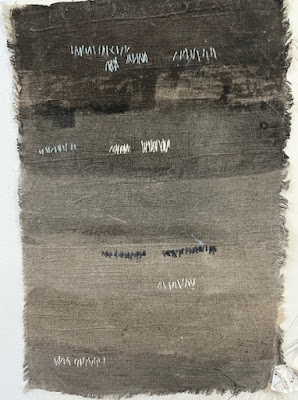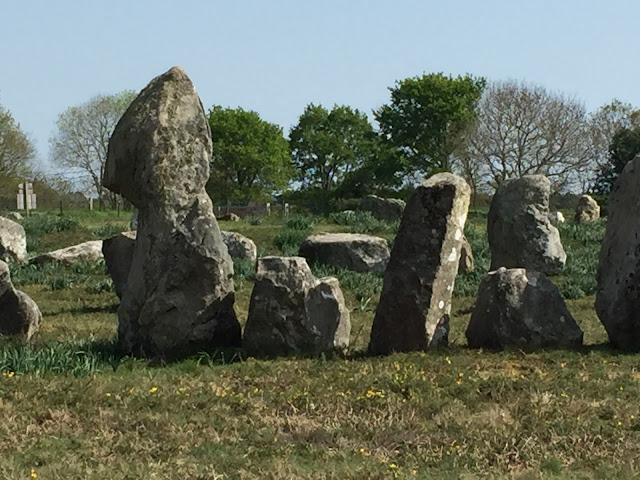Here's what I'm thinking about for my work about "persistence"--a large piece of cloth (about 90" in longest dimension), on which I stitch thousands of marks in linear configurations. I've made a full-size sketch that roughly replicates the layout of the three major alignments in Carnac. This is just a very early starting point and the final piece may bear little resemblance to this, but it's enough to serve as a kind of placeholder. Right now, it is hanging vertically on my design wall, but it may end up horizontal.
This rough sketch in place, I went on to do stitching trials, trying out the kinds of marks I might make, with what kind of thread, and in what colors. I started out with the heavy natural linen I enjoy working with (4C22 from Fabrics-Store), and a black silk-wrapped linen thread that I had on hand from Habu Textiles.
Then more sampling with different threads, this time stitching on linen that has been colored with different hues/values of earth pigments (more on earth pigments below):
This helped me decide that I prefer a light or medium-light color for the stitches, on a dark background.
In order to try out a range of colors/values for the thread, I purchased a few different flat threads from Habu, which I can dye myself. (I like how a flat thread yields unexpected shapes in the stitches.)

Here's one of the threads, dyed with 2 different light grays, though it is difficult to tell the difference in hue at this light value.
And here are trials with three different threads from Habu, all dyed very light gray:

Now to explain the earth pigmented fabric. From an early stage, I've been talking with my friend Sheryl St. Germain about this project. Sheryl and I both attended a 2022 workshop by Susan Brandeis that centered on hand-stitching. I focused on stitching that I might use for my work about menhirs, and Sheryl was working with cloth that she had painted with earth pigments, a method of coloring cloth that she had recently learned from Claire Benn. We continued to e-mail back and forth about our work after the workshop. When I wrote about my decision to not use the natural linen, along with some thoughts about dyeing the background fabric, Sheryl suggested using earth pigments instead of chemical dyes. I liked the idea of this--because of the close association of earth and stone in these neolithic monuments--but I knew from hearing about Sheryl's experience that the process of using earth pigments was very different from anything I had done before, and I just didn't have it in me to learn a whole new process that I might not use again after this one project. Sheryl then offered to color the cloth for me. This was such a deeply generous offer that I hesitated to accept, but her offer came from the heart, and I opened my heart to accept. (It happens that this was one thing that has led me to think about how hard it can be to accept help, and I'm learning that accepting help is as important to a life well lived as is giving help.)
Here are the samples that Sheryl worked up for me early in the design process, before I had decided whether I wanted the background to be light or dark. Sheryl tested three different earth pigments (all in the grayish/brown range that I wanted), in 2 or 3 different values.
I've picked the color in the lower right corner. My cloth will have the earth pigment applied late in August, and then it will need another four weeks to cure before I can work with it. This gives me the additional time I need to do some further thread trials, both of dyeing and stitching.
This is the first time that one of my personal works has become a collaborative project, and that scared me at first--how could I give over a central, physical part of the project to someone else? All of my work has been shaped significantly by extended discussion with friends and teachers, but I've always done all the actual work myself. But giving up control can be a good thing, and having Sheryl move forward with the cloth experiments has helped keep me moving forward on my part of the project. And of course our discussions all along the way have helped me find my way to the composition this will become.
THANK YOU SHERYL!!



















